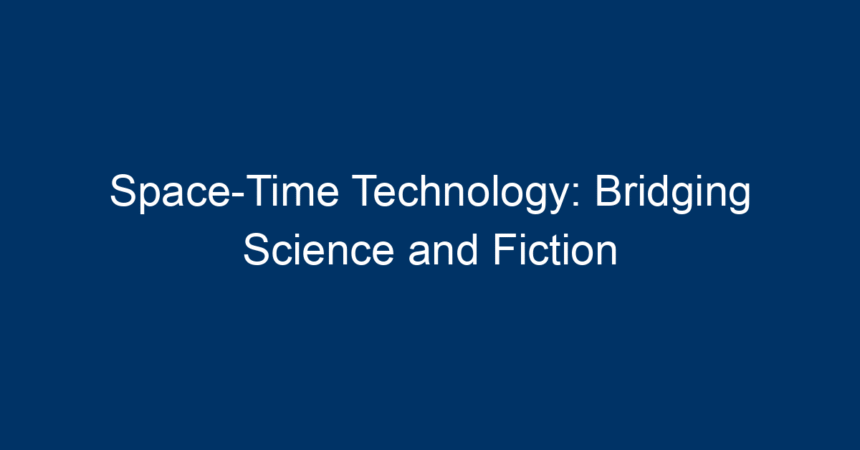The concept of space-time technology has long fascinated scientists, writers, and dreamers alike. Stretching our imagination to the limits of possibility, it merges the realms of science and science fiction. Whether we’re delving into the depths of theoretical physics or exploring the thrilling narratives found in sci-fi literature, the implications of space-time technology offer a treasure trove of intriguing possibilities. Let’s unravel how this captivating concept connects to our current understanding of the universe and what it could mean for humanity in the future.
Understanding Space-Time
Before diving into space-time technology, it’s crucial to grasp what space-time actually is. Albert Einstein introduced the concept, describing it as a four-dimensional continuum that unites space and time into a single entity. This framework suggests that the fabric of the universe consists of both spatial and temporal dimensions that intertwine and influence one another.
In simple terms, think of space-time as a vast, intricate web. Any disturbance, whether from a mass moving through space or the passage of time, subtly alters the structure of the web. This groundbreaking understanding has been vital for advancements in physics, astronomy, and our comprehension of reality.
Theoretical Foundations of Space-Time Technology
General Relativity
Einstein’s theory of general relativity lays the groundwork for space-time technology. It posits that massive objects like planets and stars give rise to gravitational fields that curve space-time around them. This curvature is what we perceive as gravity. The implications of this are profound: if we can manipulate space-time, we may well have the keys to traversing vast distances, altering our perception of time, and much more.
Quantum Mechanics
On the other end of the spectrum lies quantum mechanics, the study of interactions at the atomic and subatomic levels. The marriage of quantum mechanics with general relativity remains one of the most tantalizing puzzles in modern physics. Some theorists posit that understanding how these two realms work together could unlock revolutionary technologies based on space-time manipulation.
Bridging Science and Fiction
Space-Time Travel: A Common Motif
The idea of space-time travel is a recurrent theme in science fiction, captivating generations of readers and audiences. From the DeLorean in "Back to the Future" to the TARDIS in "Doctor Who," popular media has vividly depicted the possibilities and pitfalls of time travel. These narratives often explore the consequences of tampering with time, raising philosophical questions about determinism and free will.
In reality, while we may not yet have the technology seen in these stories, the idea of time travel is not solely the domain of fiction. Concepts like wormholes, black holes, and even the theoretical idea of a warp drive suggest that science could one day inch closer to this captivating frontier.
Wormholes: Bridges in Space-Time
Wormholes are theoretical passages through space-time that could connect distant points. Imagine a tunnel connecting two points in a vast landscape—this is akin to what wormholes offer in the universe. If space-time technology is to evolve, understanding and potentially harnessing wormholes will be essential.
Some scientists propose that manipulating energy around a black hole could create such passages, enabling rapid travel across vast cosmic distances or even allowing for time travel. However, significant technological advances would be required to make this a reality.
Practical Applications of Space-Time Technology
While space-time travel often dominates the conversation, the potential applications of space-time technology extend far beyond just navigating the cosmos. Here are a few practical implications worth considering:
GPS Technology
The Global Positioning System (GPS) is a perfect example of space-time technology in action. GPS satellites orbiting Earth function based on the principles of general relativity. They must account for time dilation—where time moves differently in relation to gravitational fields—allowing for accurate location tracking. This technology today transcends science fiction; it’s an integral part of daily life, proving that space-time theory is already shaping our world.
Advancements in Communication
As our understanding of space-time technology deepens, we may revolutionize how we communicate across vast distances. Quantum entanglement, a phenomenon that Albert Einstein famously dismissed as “spooky action at a distance,” could enable instantaneous communication regardless of location. The potential for instantaneous information exchange could reshape industries, education, and personal relationships.
Energy Generation
Some researchers speculate that manipulating space-time could lead to groundbreaking advancements in energy generation. Theoretically, if we can harness the energy fluctuations inherent in the fabric of space-time, we may discover new, sustainable energy sources, reducing our reliance on fossil fuels and moving towards a greener planet.
The Ethical Implications of Space-Time Technology
With great power comes responsibility. The advancement of space-time technology raises numerous ethical considerations:
Time Travel and Its Consequences
If humanity were to achieve time travel, the implications could be catastrophic. From altering historical events to impacting entire civilizations, the consequences of meddling with the past could be irreversible. It raises profound questions about scientific responsibility and the moral implications of technological advancements.
Surveillance and Privacy
As technologies evolve, so does the potential for misuse. Space-time technology could be employed for surveillance, leading to violations of privacy. Thus, it’s essential to establish ethical guidelines and frameworks to navigate these challenges.
The Future of Space-Time Technology
As we continue to delve deeper into understanding the complexities of space-time, the future holds unimaginable possibilities. While immediacy in achieving practical space-time technology might seem distant, ongoing research is paving the way for breakthroughs.
The fusion of theories in physics, advancements in technology, and interdisciplinary collaborations could result in the emergence of real-world applications that seem only plausible in fiction today. The continual exploration of the universe serves as a reminder of humanity’s quest for knowledge—to not only understand our existence but to push the boundaries of what is conceivable.
Conclusion: Embracing the Possibilities
The journey into the realm of space-time technology is just beginning. As we continue to explore the intersection of science and fiction, we must also navigate the implications of our discoveries responsibly. It is the responsibility of scientists, policymakers, and society at large to shape a future where such transformative technologies serve the common good.
The captivating blend of ambition, intellect, creativity, and ethical considerations will chart our path forward in this exciting field. As we stand on the precipice of a new era in technology and exploration, the question remains: how will we harness the unfathomable power of space-time? The future is ripe with possibilities, and it’s up to us to ensure that it is a future worth striving for.
Action Steps:
- Stay informed about the advancements in space-time technology.
- Support responsible research and ethical guidelines in scientific exploration.
- Encourage interdisciplinary collaborations that drive innovation.
- Engage with literature and media that explore these concepts, fostering curiosity and imagination.
By fostering a culture of exploration and understanding, we can bridge the gap between the theoretical and the practical—a journey not just through space, but through time itself.




